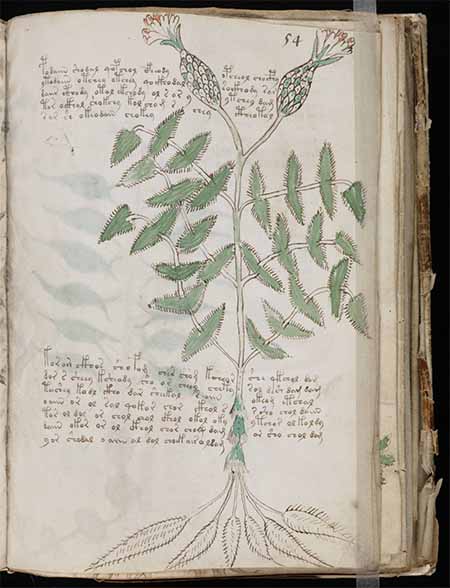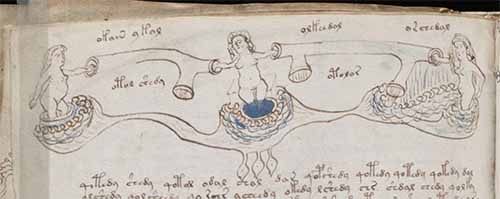The Voynich Manuscript
An Unknown Alphabet

One day in 1912, Wilfrid Voynich, a wealthy American bibliophile and antiquarian, went to the former Jesuit convent of the Villa Mondragone in Frascati, near Rome. It will be an unforgettable day for him. Father Strickland, who receives him, shows him a small book measuring 22 by 16 centimeters, which is in the convent library after passing through the hands of several owners. It has 102 sheets, or 204 pages of illustrations and texts written in an unknown language. However, there are 24 pages torn off and lost in the past.
What then is the content of this mysterious manuscript ? The only thing we are sure of is that it has 250,000 characters for 4,000 words that are completely unreadable. The book contains a large number of illustrations almost as mysterious as the texts. The manuscript is now known by the name of its last owner, Wilfrid Voynich. For the rest, the mystery is total: we ignore the author, the time and the purpose. The field therefore opens up to all kinds of hypotheses.
A challenge for specialists
The Voynich manuscript is a mysterious book, probably centuries old. To decrypt his code - assuming there was one - we went so far as to use the most powerful computers of the American secret services. Unfortunately, this has lead to years of unnecessary work that has resulted in no certainty. The teams of specialists who have studied the enigma have suffered the same fate. The Voynich manuscript seems to jealously guard its secret. Indeed, none of the solutions proposed is applicable to the entire text. The first part was called Herbal and contains 113 drawings of plants not yet identified.

The second, called Astronomical, presents 25 diagrams which resemble an astral chart, where we believe we recognize the Sun, the Moon and several constellations of our galaxy. The third part, which is called Balneological, reproduces no less than 227 images of naked women, some of whom are pregnant and immersed in bathtubs connected to strange pipes. The fourth part, finally, called Pharmaceutical, shows hundreds of roots, small plants and various containers of spices. There is also a final section which looks like a sort of index and contains only text.

Who wrote the Voynich manuscript and what does it contain ?
The alleged author of the Voynich manuscript - or, in any case, the one most often cited as such - is Roger Bacon, philosopher and “magician” of the 13th century. It is to the philosopher William Newbold that we first owe this assertion: in 1921, he also assured that the contents of the Voynich manuscript revealed surprising discoveries in astronomy and biology. Twenty years later, lawyer Joseph Feely came to the same conclusions.
However, neither of the two translations of the Voynich manuscript convinced the specialists, so that attempts at interpretation succeeded one after the other. In 1987, the American doctor Lev Levitov maintains that the Voynich manuscript is the last surviving copy of the manual of ritual suicide of the Cathars, exterminated in France in the 13th century.
More theories
However, another hypothesis fascinates the experts. It is about the Key of Solomon, a particularly powerful magic text whose Voynich manuscript could be the encrypted transcription, produced by Bacon to save the precious document from the fury of the Inquisition and pass it on to future generations. Still other researchers go so far as to assert that more than a code, it is a true unknown language, perhaps of extraterrestrial origin. Finally, scientist Gordon Rugg says that it would be a simple historical hoax. It seems indeed that in 1586, the emperor Rudolf II of Bohemia bought the Voynich manuscript at an exorbitant price, the believer of Bacon. However, in those years, two Englishmen with ambiguous reputation lived in Prague, the adventurer Edward Kelley and the magician and astrologer John Dee. And according to Rugg, they could very well have created the Voynich manuscript from scratch.









































































































































































































































































































































